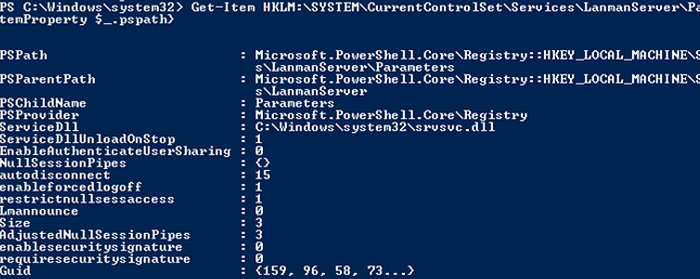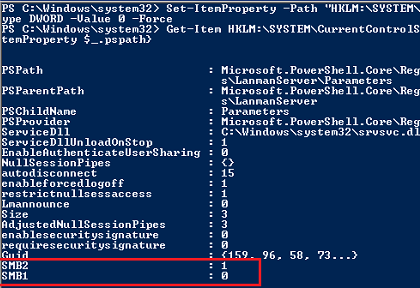How To Check Smb Version On Windows Server 2003
The Server Bulletin Block (SMB) network protocol is used to share and admission folders, files, printers, and other devices over network (TCP port 445). In this commodity, nosotros volition look at which versions (dialects) of SMB are available in unlike versions of Windows (and how they relate to samba versions on Linux); how to check the SMB version in utilise on your computer; and how to enable or disable the SMBv1, SMBv2, and SMBv3 dialects.
Contents:
- SMB Protocol Versions in Windows
- How to Bank check SMB Version on Windows?
- Checking Used SMB Dialects with Become-SMBConnection
- Stop Using the Insecure SMBv1 Protocol
- How to Enable and Disable SMBv1, SMBv2, and SMBv3 on Windows?
SMB Protocol Versions in Windows
There are several versions of the SMB protocol (dialects) that accept consistently appeared in new Windows versions (and samba) :
- CIFS – Windows NT four.0
- SMB 1.0 – Windows 2000
- SMB 2.0 – Windows Server 2008 and Windows Vista SP1 (supported in Samba 3.half-dozen)
- SMB 2.1 – Windows Server 2008 R2 and Windows 7 (Samba 4.0)
- SMB 3.0 – Windows Server 2012 and Windows viii (Samba 4.2)
- SMB 3.02 – Windows Server 2012 R2 and Windows 8.i (non supported in Samba)
- SMB 3.one.1 – Windows Server 2016 and Windows 10 (not supported in Samba)
Samba is used to implement the SMB protocol in Linux/Unix . Samba 4.fourteen and newer uses SMB 2.1 by default.
In SMB network advice, the client and server use the maximum SMB protocol version supported by both the customer and the server.
The summary table of SMB version compatibility looks like this. Using this table, you can determine the version of the SMB protocol that is selected when different versions of Windows interact:
| Operating System | Windows 10, Win Server 2016 | Windows viii.i, Win Server 2012 R2 | Windows 8,Server 2012 | Windows vii,Server 2008 R2 | Windows Vista,Server 2008 | Windows XP, Server 2003 and earlier |
| Windows 10, Windows Server 2016 | SMB 3.one.ane | SMB three.02 | SMB three.0 | SMB ii.i | SMB 2.0 | SMB 1.0 |
| Windows 8.ane, Server 2012 R2 | SMB 3.02 | SMB three.02 | SMB 3.0 | SMB 2.1 | SMB 2.0 | SMB 1.0 |
| Windows viii, Server 2012 | SMB 3.0 | SMB 3.0 | SMB 3.0 | SMB two.1 | SMB 2.0 | SMB 1.0 |
| Windows 7, Server 2008 R2 | SMB two.1 | SMB 2.1 | SMB 2.1 | SMB 2.one | SMB 2.0 | SMB one.0 |
| Windows Vista, Server 2008 | SMB 2.0 | SMB 2.0 | SMB ii.0 | SMB 2.0 | SMB 2.0 | SMB 1.0 |
| Windows XP, 2003 and before | SMB 1.0 | SMB 1.0 | SMB 1.0 | SMB one.0 | SMB ane.0 | SMB 1.0 |
For example, if a client computer running Windows 8.ane connects to a file server with Windows Server 2016, the SMB iii.0.2 protocol volition be used.
Co-ordinate to the table, Windows XP and Windows Server 2003 tin can use but SMB 1.0 to access shared folders and files. The SMBv1 is disabled in newer versions of Windows Server (2012 R2/2016). So, if you lot are nonetheless using Windows XP and Windows Server 2003 devices on your network, they won't be able to admission shared folders on the file server running Windows Server 2016.
If Windows Server 2019/2016 with disabled SMB v1.0 is used as a domain controller, then Windows XP/Server 2003 clients won't be able to access the SYSVOL and NETLOGON folders on domain controllers and authenticate with Advertising.
You may receive the post-obit mistake when trying to connect to a shared folder on a file server with SMBv1 disabled:
The specified network name is no longer available
How to Check SMB Version on Windows?
Let's look on how to find out which versions of the SMB are enabled on your Windows device.
On Windows 10/eight.one and Windows Server 2019/2016/2012R2, you tin check the condition of various dialects of the SMB protocol using PowerShell:
Get-SmbServerConfiguration | select EnableSMB1Protocol,EnableSMB2Protocol

This command returned that the SMB1 protocol is disabled (EnableSMB1Protocol = True), and the SMB2 and SMB3 protocols are enabled (EnableSMB1Protocol = False).
Note that the SMBv3 and SMBv2 protocols are closely related. You cannot disable or enable SMBv3 or SMBv2 separately. They are always enabled/disabled only together considering they share the same stack.
On Windows 7, Vista, and Windows Server 2008 R2/2008:
Go-Item HKLM:\SYSTEM\CurrentControlSet\Services\LanmanServer\Parameters | ForEach-Object {Get-ItemProperty $_.pspath}
If there are no parameters named SMB1 or SMB2 in this registry key, then the SMBv1 and SMBv2 protocols are enabled by default.

As well on these Windows versions, y'all tin check which SMB client dialects are allowed to connect to remote hosts:
sc.exe query mrxsmb10
SERVICE_NAME: mrxsmb10 TYPE : 2 FILE_SYSTEM_DRIVER Land : four RUNNING (STOPPABLE, NOT_PAUSABLE, IGNORES_SHUTDOWN) WIN32_EXIT_CODE : 0 (0x0) SERVICE_EXIT_CODE : 0 (0x0) CHECKPOINT : 0x0 WAIT_HINT : 0x0
sc.exe query mrxsmb20
SERVICE_NAME: mrxsmb20 Blazon : two FILE_SYSTEM_DRIVER STATE : four RUNNING (STOPPABLE, NOT_PAUSABLE, IGNORES_SHUTDOWN) WIN32_EXIT_CODE : 0 (0x0) SERVICE_EXIT_CODE : 0 (0x0) CHECKPOINT : 0x0 WAIT_HINT : 0x0
In both cases, the services are running (STATE = 4 Running). This ways that the current Windows device can connect to both SMBv1 and SMBv2 hosts.
Checking Used SMB Dialects with Go-SMBConnection
When communicating over SMB, computers utilise the maximum SMB version supported by both the client and the server. The Become-SMBConnection PowerShell cmdlet tin can be used to cheque the SMB version used to access a remote calculator:

The SMB version used to connect to the remote server (ServerName) is listed in the Dialect column.
You can display information almost the SMB versions used to access a specific server:
Become-SmbConnection -ServerName srvfs01
If you want to display if SMB encryption is in use (introduced in SMB three.0):
Get-SmbConnection | ft ServerName,ShareName,Dialect,Encrypted,UserName
On Linux, you lot can display a listing of SMB connections and used dialects in samba using the control:
$ sudo smbstatus
On the Windows SMB server side, you tin display a listing of the versions of the SMB protocols that the clients are currently using. Run the command:
Get-SmbSession | Select-Object -ExpandProperty Dialect | Sort-Object -Unique

You tin can employ PowerShell to enable auditing of the SMB versions used for the connection:
Ready-SmbServerConfiguration –AuditSmb1Access $truthful
SMB connection events tin can and then be exported from Issue Viewer logs:
Become-WinEvent -LogName Microsoft-Windows-SMBServer/Audit
Stop Using the Insecure SMBv1 Protocol
Over the past few years, Microsoft has systematically disabled the legacy SMB 1.0 protocol in all products for security reasons. This is due to the large number of disquisitional vulnerabilities in this protocol (remember the incidents with wannacrypt and petya ransomware, which exploited a vulnerability in the SMBv1 protocol). Microsoft and other IT companies strongly recommend that you terminate using SMBv1 in your network.
Yet, disabling SMBv1 tin can cause problems with accessing shared files and folders on newer versions of Windows 10 (Windows Server 2016/2019) from legacy clients (Windows XP, Windows Server 2003), third-party OS (Mac OSX 10.8 Mount Lion, Snow Leopard, Mavericks, erstwhile Linux distros), one-time NAS devices.
If there are no legacy devices left on your network that back up only SMBv1, be sure to disable this SMB dialect in Windows.
If you take clients running Windows XP, Windows Server 2003, or other devices that merely back up SMBv1, they should be updated or isolated.
How to Enable and Disable SMBv1, SMBv2, and SMBv3 on Windows?
Let'south look at means to enable and disable unlike SMB versions on Windows. We'll cover SMB client and server management (they are different Windows components).
Windows 10, 8.i, and Windows Server 2019/2016/2012R2:
Disable SMBv1 client and server:
Disable-WindowsOptionalFeature -Online -FeatureName smb1protocol
Disable SMBv1 server only:
Set-SmbServerConfiguration -EnableSMB1Protocol $false
Enable SMBv1 client and server:
Enable-WindowsOptionalFeature -Online -FeatureName smb1protocol
Enable just SMBv1 server:
Set up-SmbServerConfiguration -EnableSMB1Protocol $true
Disable SMBv2 and SMBv3 server:
Set-SmbServerConfiguration -EnableSMB2Protocol $false
Enable SMBv2 and SMBv3 server:
Set up-SmbServerConfiguration -EnableSMB2Protocol $true

Windows seven, Vista, and Windows Server 2008 R2/2008:
Disable SMBv1 server:
Set-ItemProperty -Path "HKLM:\SYSTEM\CurrentControlSet\Services\LanmanServer\Parameters" SMB1 -Blazon DWORD -Value 0 –Forcefulness

Enable SMBv1 server:
Set-ItemProperty -Path "HKLM:\SYSTEM\CurrentControlSet\Services\LanmanServer\Parameters" SMB1 -Type DWORD -Value 1 –Strength
Disable SMBv1 client:
sc.exe config lanmanworkstation depend= bowser/mrxsmb20/nsi
sc.exe config mrxsmb10 start= disabled
Enable SMBv1 client:
sc.exe config lanmanworkstation depend= bowser/mrxsmb10/mrxsmb20/nsi
sc.exe config mrxsmb10 first= auto
Disable SMBv2 server:
Gear up-ItemProperty -Path "HKLM:\Organisation\CurrentControlSet\Services\LanmanServer\Parameters" SMB2 -Blazon DWORD -Value 0 -Force
Enable SMBv2 server:
Set-ItemProperty -Path "HKLM:\Organization\CurrentControlSet\Services\LanmanServer\Parameters" SMB2 -Blazon DWORD -Value ane –Force
Disable SMBv2 client:
sc.exe config lanmanworkstation depend= bowser/mrxsmb10/nsi
sc.exe config mrxsmb20 start= disabled
Enable SMBv2 customer:
sc.exe config lanmanworkstation depend= bowser/mrxsmb10/mrxsmb20/nsi
sc.exe config mrxsmb20 starting time= auto
You can disable SMBv1 server on domain joined computers by deploying the post-obit registry parameter through the GPO:
- Primal: HKEY_LOCAL_MACHINE\Organization\CurrentControlSet\Services\LanmanServer\Parameters
- Name: SMB1
- Blazon: REG_DWORD
- Value: 0
Set the registry parameter SMB2=0 in guild to disable the SMBv2 server.
To disable the SMBv1 customer, you demand to propagate the post-obit registry setting:
- Key: HKEY_LOCAL_MACHINE\System\CurrentControlSet\services\mrxsmb10
- Name: Start
- Type: REG_DWORD
- Value: 4
Source: http://woshub.com/smb-1-0-support-in-windows-server-2012-r2/
Posted by: walshculdrought78.blogspot.com

0 Response to "How To Check Smb Version On Windows Server 2003"
Post a Comment